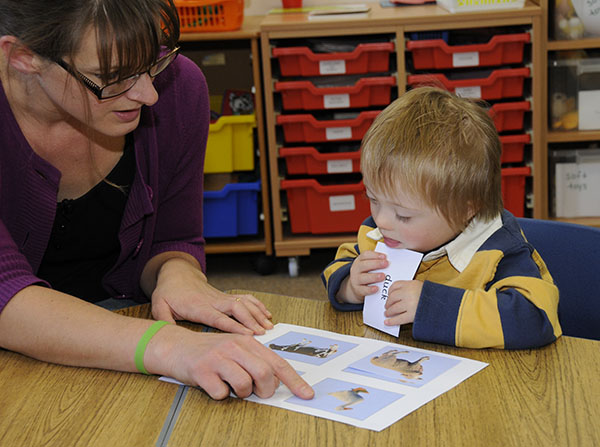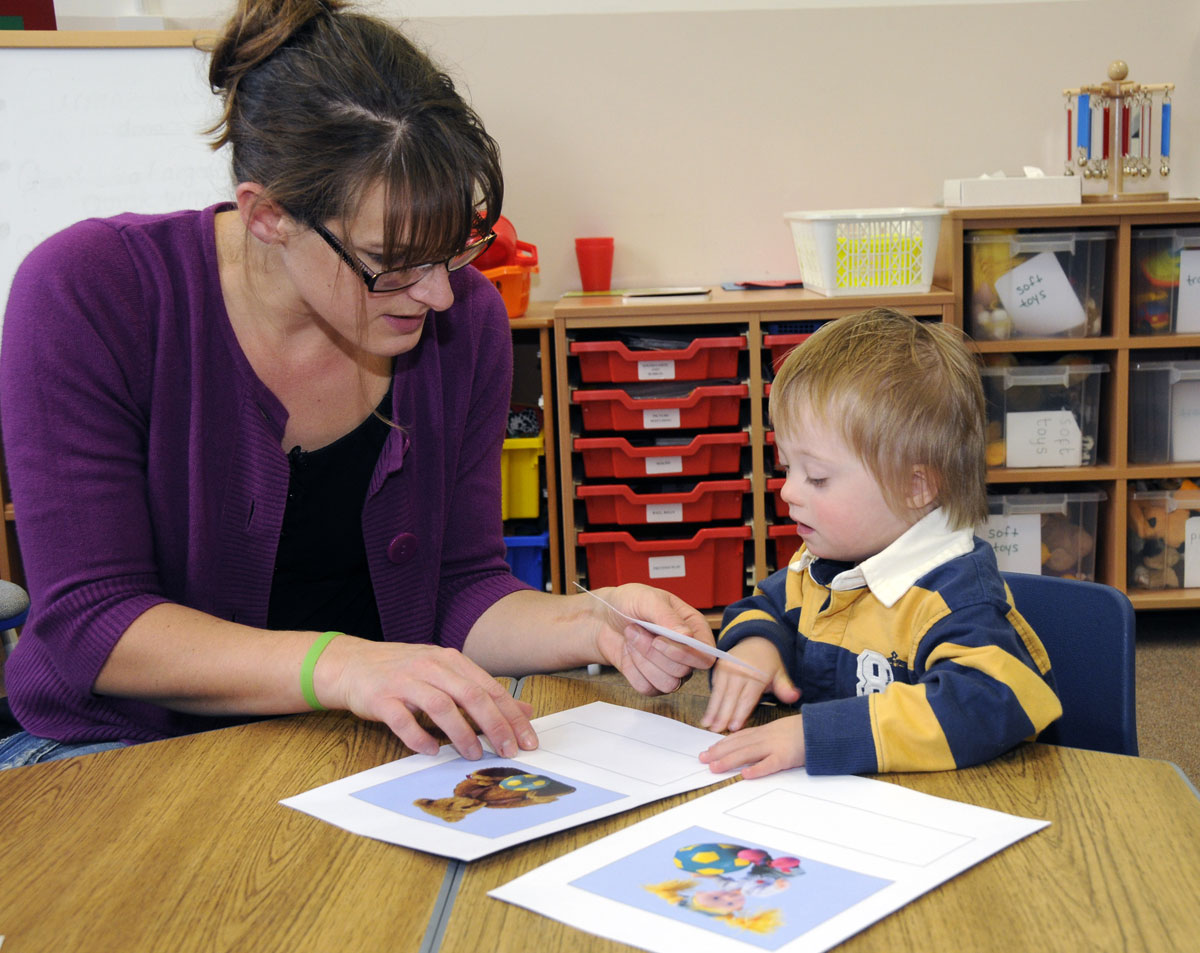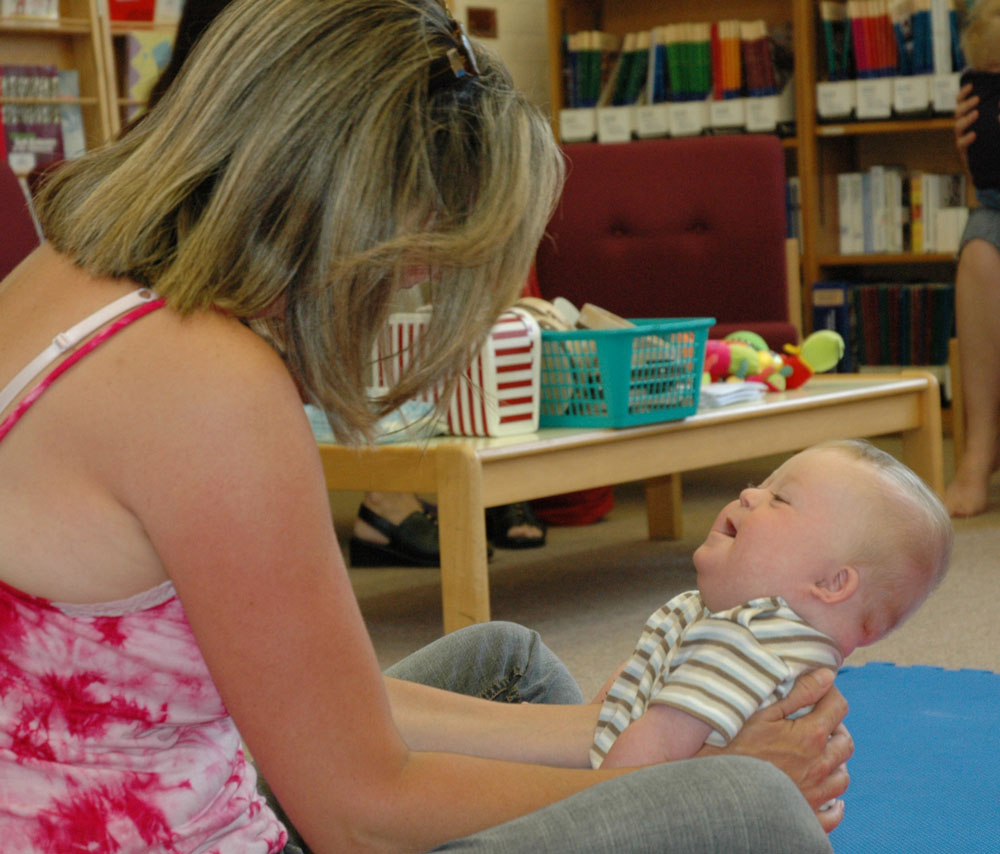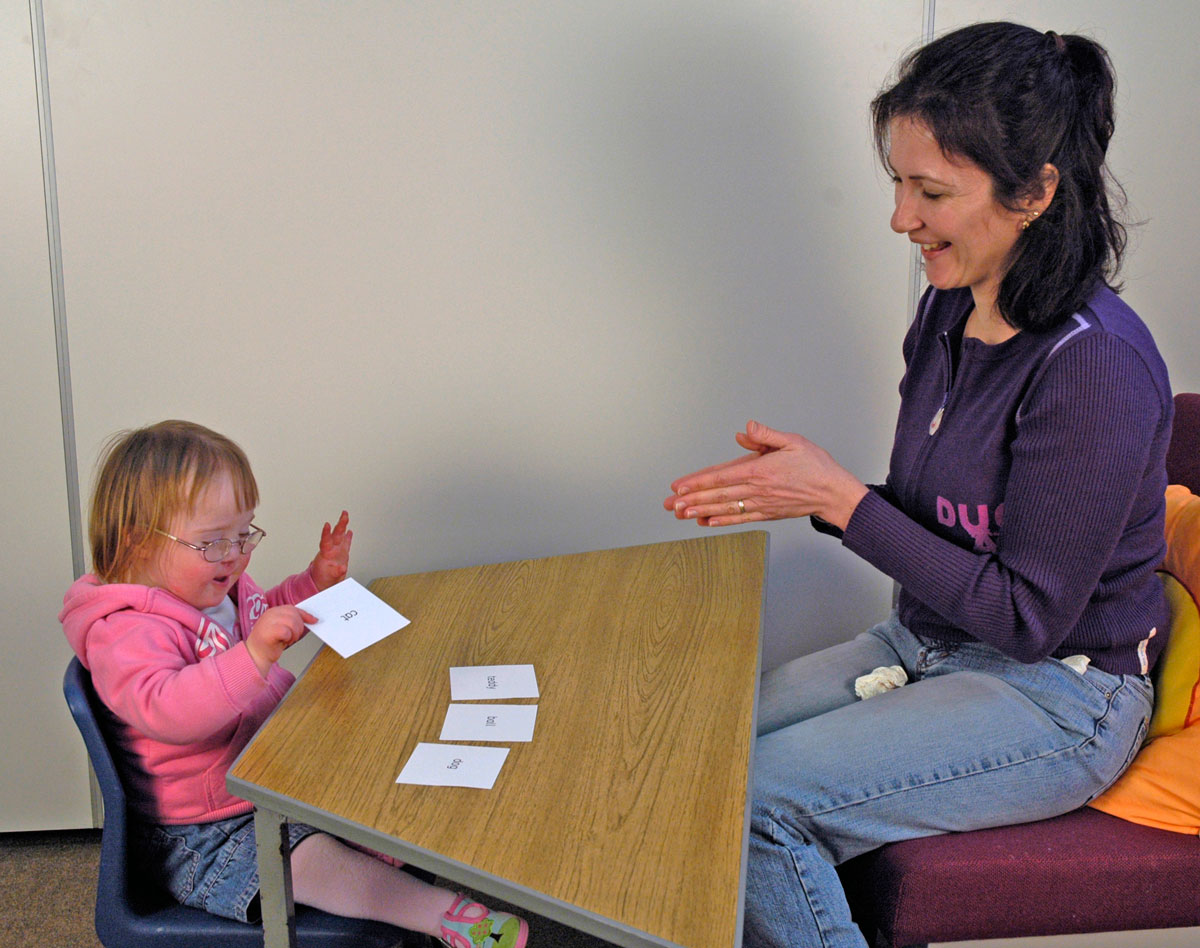Language development for children with Down syndrome
The language skills of children with Down syndrome tend to develop more slowly than for other children. There is a common pattern of relative strengths and weaknesses that can inform therapies and teaching approaches.

Learning to talk
Children learn to talk from the first year of life as they are talked to and begin to understand that the words they hear around them have meaning. Children learn to talk in an orderly developmental pattern - including children with Down syndrome.[1-4]
When considering how children learn to talk it is helpful to identify four components which underpin becoming a competent talker:
- Learning to communicate
- Learning vocabulary
- Learning sentences and grammar
- Learning to speak clearly
Learning to communicate
At first, all children communicate using gestures. They point to interesting objects and actions, hold things up to show them, and gesture to request things. When children communicate like this, people around them tend to name what they are looking at, helping them learn the meanings of spoken words.
Learning vocabulary
To learn to talk, children have to begin to understand and then use the words they hear around them every day. Children learn many different words and build a large vocabulary. As they learn to understand more and more words they are learning more about the world that they live in.

Learning sentences and grammar
At first, children use single words to communicate. Next, they begin to put two words together to express a range of meanings. Then they move on to build longer sentences and to use conventional grammatical markers (such as plural 's' - "dog", "dogs"; possessive 's' - "Daddy's car"; tense markers - 'ing', 'ed' - "jump", "jumping", "jumped") and word order rules to express different meanings (such as question forms - "Has John gone?" rather than statement "John has gone", and the order of actions - "Mary chases John" rather than "John chases Mary").
Research indicates that spoken vocabulary size is linked to these stages in spoken language development. Children generally have a spoken vocabulary of between 50 and 100 words before they begin to join 2 words together. They say 250 to 300 different words before they start to use longer sentences and grammatical markers in their spoken language.[1,5]
Research also suggests that the first 700 to 800 words that children learn to say are similar in many languages. The words children first learn are those that they hear used around them most frequently and in situations where they can 'see' what the words mean. There is considerable similarity in the vocabulary first learned by all children as their early experiences are similar - involving feeding, sleeping, washing, dressing, playing, going out and interacting with close family members.[1]
Learning to speak clearly
As children first learn to talk, their utterances are approximate attempts to say the words that they hear. Children's earliest spoken words may only be understood by their family. Typically developing children quite quickly learn to say words more clearly and most are intelligible at around 4 or 5 years of age. (This does not mean that they talk as accurately as adults but they talk well enough to be understood.)
What influences progress?
Children learn to talk at widely differing rates. There may be a number of reasons, but one of the main factors in determining how fast children learn to talk is the quantity and quality of the language they experience.[1,6] Research also suggests that the ability to repeat words is linked to the rate of early vocabulary learning.[7] Word repetition requires verbal short-term memory and speech production skills.
Children start to say their first words at around the same time that they start to play with objects in functional and symbolic ways - for example, pretending to drink from a toy cup, feed doll with a spoon, brush hair (functional) and pretending bricks are a train (symbolic). Adults talk to children during object play, naming what they are looking at and doing.
Spoken language is also learned as children are involved in conversations and as they listen to conversations with others. Most children want to communicate and often start a conversation by 'saying' something even though it may only be babble, a gesture, or a partial attempt at a word. One factor explaining why some children experience more talk than others may be that they try to start conversations more often.

Language development
Children with Down syndrome develop more slowly than typically developing children, and language skills are are an area of particular difficulty. In addition, some aspects of speech and language development are more delayed than others. This pattern is sometimes referred to as a profile of relative strengths and weaknesses.[2-4]
- Spoken language is delayed relative to cognitive development - Most children with Down syndrome develop spoken language skills more slowly than their non-verbal mental abilities. They have therefore been described as having a specific speech and language delay.
- Good early communication skills - Most children with Down syndrome are eager to communicate and their early non-verbal communication skills are good. These include making eye-contact, taking turns in babble games, developing joint attention, and using gestures. Children with Down syndrome tend to use early gestures effectively, and continue to use them for longer than typically developing children.
- Strength in learning vocabulary - Children with Down syndrome will often learn to understand what early words mean (comprehension) at a rate that might be expected for their level of non-verbal understanding (cognition). However, they are usually slower to learn to say the words (production). Over time, they steadily learn the meanings of a useful range of vocabulary but production continues to develop more slowly than comprehension. Usually, children with Down syndrome understand more than they can say.
- Weakness in learning grammar - Learning to understand and use grammar is an area of greater difficulty for most children with Down syndrome - developing more slowly than vocabulary. Many children make themselves understood by putting key words together without all of the appropriate grammar - for example, "me go school bus", rather then "I go to school on the bus". However, studies suggest that, while development is slower, young people with Down syndrome can continue to learn grammar and sentence structures through the teenage years.
- Difficulties speaking clearly - Children with Down syndrome typically babble like other children. However, they do not move on to attempt to say words but tend to use more gestures for longer than other children with a similar level of understanding. This may be because children with Down syndrome find speech production and saying words more difficult.
- Wide range of individual differences - Studies of vocabulary development suggest that children progress at different rates, with some children with Down syndrome saying less than 50 words at 3 years and others over 300 words (though this variation is also true of younger typically developing children at the same cognitive level).[7]
- Same developmental order and pattern - Studies indicate that children with Down syndrome develop spoken language skills and learn vocabulary and grammar in the same order as other children. Similarly, studies have found the same links between spoken vocabulary size, combining words and developing grammar for children with Down syndrome as other children.[8,9]
It is important to note that much of the research examining the speech and language development of children with Down syndrome describes outcomes for children who have not always received optimal teaching and therapy. Some studies suggest that this pattern is not inevitable and that good quality teaching and speech and language intervention can improve outcomes for children with Down syndrome.[3,4]
Why this pattern?
A number of factors probably contribute to the pattern of speech and language development observed among children with Down syndrome. These also provide some guidance for intervention.
- Hearing loss - Many children with Down syndrome experience hearing loss in the early years and this has been shown to influence their spoken language development.[10] Medical care guidelines recommend regular hearing tests for all children with Down syndrome.
- Speech sound discrimination - Typically developing children can discriminate between the sounds in their native spoken language in the first weeks of life. Speech sound discrimination and production skills at around 7 to 10 months predict later progress in learning to use spoken words. There is no similar research into speech discrimination in children with Down syndrome in the first year of life but we know their production is delayed.[2-4]. Hearing problems are likely to influence the ability to discriminate between sounds, and this will affect a child's ability to learn to understand words as well as to say them. For example, consider "cat", "hat", "mat", "sat", and "bat" - these are all early words with only one differing sound, but each has a different meaning. Even a mild hearing loss may make it difficult to distinguish between these words when spoken.
- Storing spoken word patterns - Studies suggest that children with Down syndrome may have more difficulty in learning and storing accurate sound patterns for words (phonological representations).[11] This may influence their ability to discriminate between, and learn the meaning of, similar sounding words. It may also influence their ability to say the words accurately. It is possible that additional repetition and practice may help.
- Cognitive delay - Children with Down syndrome generally develop and learn more slowly than typically developing children. They may find it more difficult to pick up word meanings from everyday conversations, and may need more exposure to words in order to link word to meaning. All children learn their first words from hearing them stressed as single words - not just in sentences.[12]
- Less input - There is some evidence that children with Down syndrome experience less conversation with their parents than other children.[13] If they are not attempting sounds and words as often as other children, they may be talked to less often. If they are talked to less often, the children have fewer opportunities to learn words and to practice saying them.
- Verbal short-term memory - Most children with Down syndrome have particular difficulties with verbal short term memory. Verbal short term memory is important for holding verbal information and influences word learning. A number of studies have shown a link between verbal short term memory and learning grammar and syntax. In contrast, visual spatial short term memory is a relative strength for children with Down syndrome.[3,4]
Intervention studies
There are some research studies exploring the effectiveness of language interventions for children with Down syndrome. Although many more are needed, we can identify some guidance from those available:
- Intensity is important - Researchers in the USA have shown that intervention sessions for toddlers provided 5 times each week over 9 months can lead to greater progress in saying first words than one session each week.[14] The intervention was play based and a therapist engaged the children in play with objects but also included direct teaching of words and encouraging imitation. Parents also received training in how to communicate effectively and teach their children. This team recommend more intensity and longer duration of interventions in order to make a difference [15]
- Repetition and prompting - A recent study looked at the strategies parents used to teach new words to their toddlers with Down syndrome. The study found that asking the child to repeat words and prompting them say words were the most effective strategies.[16] A number of studies have shown that repeating words, encouraging imitation, and using visual supports (pictures, written words) can help children with Down syndrome to learn words and sentences.[3,4]

Implications for teaching children with Down syndrome
Considering what is understood about language development generally, and what is understood about the difficulties experienced by children with Down syndrome, we can draw out a number of principles and observations to inform language teaching, consistent with the available evidence. We have incorporated these in the design of See and Learn Language and Reading:
- Offer lots of everyday opportunities to learn language - Children with Down syndrome learn language all day, everyday. They learn as they are talked to and communicate at home, preschool and at school, and it is important that parents and educators make full use of all the language learning opportunities that occur during play and everyday activities. See and Learn Language and Reading is designed to supplement these.
- Provide additional, structured activities to explicitly teach language - Children with Down syndrome are likely to benefit from more opportunities to learn to understand and to say words and sentences, and to practice and consolidate their learning. Additional teaching is likely to be more effective if carefully planned and structured to explicitly teach language skills appropriate to a child's level of understanding. See and Learn Language and Reading provides a methodical approach to explicitly teach vocabulary, sentences and grammar, with lots of opportunities for repetition.
- Teach language in steps that follow the typical patterns in language development - There is much similarity in the early vocabulary learned by all children and it makes sense to explicitly teach new words in the order in which they are usually learned. See and Learn Language and Reading introduces new vocabulary, and introduces new sentence structures and grammar, in developmental order. The links between vocabulary size and grammar development are reflected in the progression between the different steps in See and Learn Language and Reading. Two key word phrases are introduced when the child has learned between 50 and 100 spoken words. Longer sentences and grammar are introduced when the child has learned between 250 and 300 spoken words.
- Utilize visual prompts to support learning - Verbal short term memory difficulties and hearing problems can make it more difficult for children with Down syndrome to learn by listening alone. Visual prompts can help support learning by using their better visual spatial memory. See and Learn Language and Reading uses pictures to illustrate words, then introduces written words to provide visual representations of single words, short phrases and then longer phrases and sentences.
- Teach in small steps - To reduce demands on working memory, and to simplify learning activities, it is often beneficial to break down teaching tasks into small steps. See and Learn Language and Reading provides simple, short activities to introduce, teach and test the understanding of new vocabulary, written and spoken words, phrases and sentences. The basic activities (matching, selecting, naming) are first learned with pictures when teaching vocabulary, and then used again with written words to teach sight words and sentences.
- Encourage success - Learning can be difficult for children with Down syndrome and can require a lot of practice. It is important to engage the children, and to motivate them. Throughout See and Learn Language and Reading, we encourage you to model activities, to prompt success and encourage 'errorless' approaches to teaching.
- Keep records of your child's progress - In addition to recording your child's achievements, records are also important for identifying the next learning targets and when it is appropriate to start certain activities. Records are also helpful for communicating with teachers and therapists and ensuring everyone has a good understanding of your child's current language skills. See and Learn Language and Reading includes record sheets to record progress in understanding vocabulary and in saying new words and sentences.
Teaching speech skills
Many children will also benefit from a structured approach to developing speech skills - from early sound discrimination and production, through simple sound combinations to saying whole words clearly. Some children will receive regular input from a speech and language therapist or pathologist to support the development of speech production and language skills.
The See and Learn Speech program is designed to supplement the language teaching activities in See and Learn Language and Reading with activities focused on improving speech clarity. See and Learn Speech can be used under the guidance of a speech and language therapist/pathologist, but is also designed to be easy for parents and educators to use independently. Children with Down syndrome are likely to benefit from regular, structured speech practice incorporated into daily life at home and at school.
Speech, language and reading skills all influence each other. The more children understand, the more they can say. Learning to read can help to teach words that cannot be pictured. The more children talk, the clearer their speech is likely to become. The clearer their speech becomes, the more likely people are to engage them in conversations and the more practice they get at speaking and the more opportunities they have to learn new words.
References
- Clark, E.C. (2016) First language acquisition. 3rd Edition Cambridge, UK: Cambridge University Press. https://www.cambridge.org/9780521732932
- Abbeduto, L., Arias-Trejo, N., Thurman, A.J., Ramos-Sanchez, J. & del Hoyo Soriano, L. (2020) Language development in Down syndrome. In J.A. Burack, J.O. Edgin, Abbeduto, L. & Busciglio, J. The Oxford Handbook of Down Syndrome and Development. OUP online doi: 10.1093/oxfordhb/9780190645441.013.18
- Abbeduto, L., Warren, S. F. and Conners, F. A. (2007), Language development in Down syndrome: From the prelinguistic period to the acquisition of literacy. Mental Retardation and Developmental Disabilities Research Reviews, 13, 247-261. doi:10.1002/mrdd.20158
- Martin, G.E., Klusek, J., Estigarribia, B. & Roberts, J.E. (2009) Language characteristics of individuals with Down syndrome. Topics in Language Disorders 29. 112-132. https://www.ncbi.nlm.nih.gov/pmc/articles/PMC2860304/
- Bates, E., & Goodman, J.C. (1999)On the emergence of grammar from the lexicon. In B. MacWhinney (Ed) The emergence of language pp29-70. LEStokes, S. F. and Klee, T. (2009), Factors that influence vocabulary development in two-year-old children. Journal of Child Psychology andPsychiatry, 50: 498-505. doi:10.1111/j.1469-7610.2008.01991.x
- Rowe, M.L. & Snow, C.E. (2020) Analyzing input quality along three dimensions: interactive, linguistic, and conceptual. Journal of Child Language, 47, 5–21 doi:10.1017/S0305000919000655
- Stokes, S. F. and Klee, T. (2009), Factors that influence vocabulary development in two-year-old children. Journal of Child Psychology and Psychiatry, 50: 498-505. doi:10.1111/j.1469-7610.2008.01991.x
- Galeote, M., Soto, P., Sebastian, E., Checa, E. & Sanchez-Palacios, C. (2014). Early grammatical development in Spanish children with Down syndrome . Journal of Child Language, 41, 111-131. doi:10.1017/S0305000912000591
- Zampini, L. and D'Odorico, L. (2011), Lexical and syntactic development in Italian children with Down's syndrome. International Journal of Language and Communication Disorders, 46, 386-396. doi:10.3109/13682822.2010.508764
- Laws, G. and Hall, A. (2014), Early hearing loss and language abilities in children with Down syndrome. International Journal of Language and Communication Disorders, 49, 333-342. doi:10.1111/1460-6984.12077
- Jarrold, C., Thorn, A.S.C., & Stephens, E. (2009). The relationships among verbal short-term memory, phonological awareness, and new word learning: Evidence from typical development and Down syndrome. Journal of Experimental Child Psychology, 102(2), 196-218. doi:10.1016/j.jecp.2008.07.001
- Brent, M.R. & Siskind, J.M. (2001)The role of exposure to isolated words in early vocabulary development. Cognition, 81(2), B33- B44. doi:10.1016/S0010-0277(01)00122-6
- Thiemann-Bourque, K.S., Warren, S.F., Brady, N., Gilkerson, J. & Richards, J.A. (2014) Vocal interaction between children with Down syndrome and their parents. American Journal of Speech-Language Pathology, 23(3), 474-485. https://www.ncbi.nlm.nih.gov/pmc/articles/PMC4257479/
- Yoder, P., Woynaroski, T., Fey, M. Warren S. Gardner, E (2015) Why dose frequency affects spoken vocabulary in pre-schoolers with Down syndrome. American Journal on Intellectual and Developmental Disabilities, 120, 302-314. https://www.ncbi.nlm.nih.gov/pmc/articles/PMC4059517/
- Warren, S.F., Bredin-Oja, S.L., Hahn, L.J. & Brady, N. (2020) Communication and language interventions for children with Down syndrome. In J.A. Burack, J.O. Edgin, Abbeduto, L. & Busciglio, J. The Oxford Handbook of Down Syndrome and Development. OUP online doi: 10.1093/oxfordhb/9780190645441.013.26
- Adamson, L.B., Bakeman, R. & Brandon, B. (2015) How parents introduce new words to young children: the influence of development and developmental disorders. Infant Behavior and Development, 39, 148-158. doi:10.1016/j.infbeh.2015.02.008

